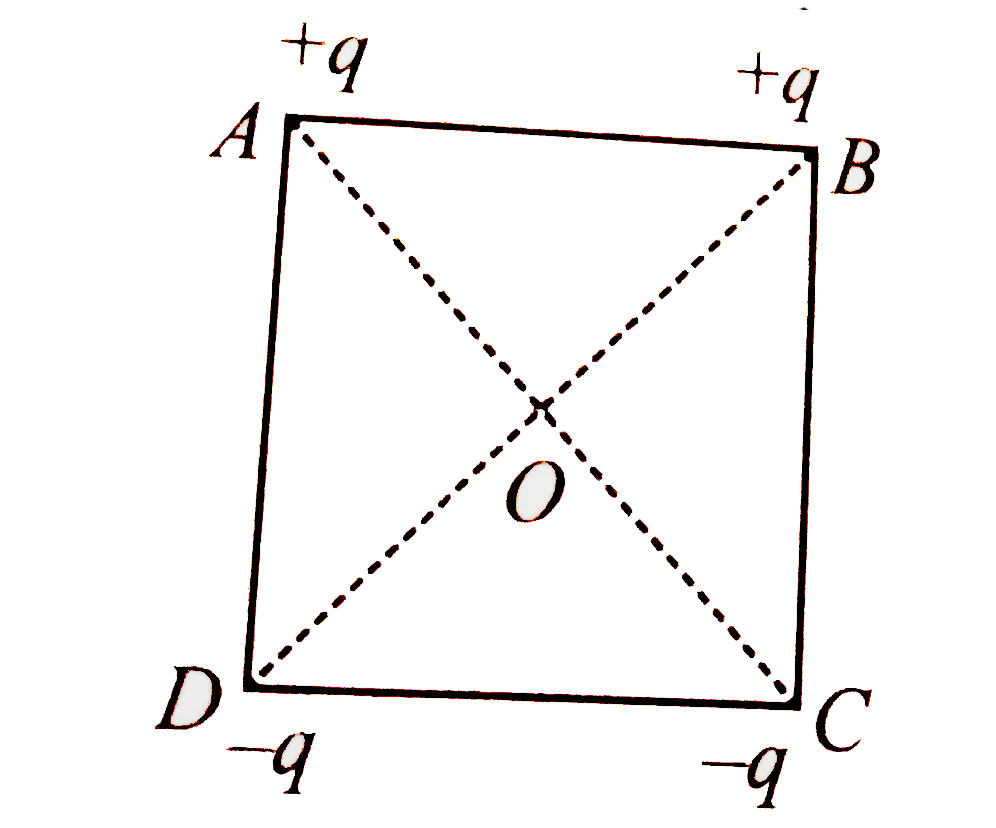Four charges are arranged at the corners of a square ABCD of side d, as shown in Fig. Find the work required to put together this arrangement
(b) A charge q0 brought to the center E of the square, the four charges being held fixed at the corners . How much extra work in needed to do this ?

(a) Since the work done depends on the final arrangement of the charges, and not on how they are put together, we calculate work needed for one way of putting the charges at A, B, C and D. Suppose, first the charge + q is brought to A, and then the charges – q, + q, and – q are brought to B, C and D, respectively. The total work needed can be calculated in steps:
(i) Work needed to bring charge + q to A when no charge is present elsewhere: this is zero.
(ii) Work needed to bring – q to B when + q is at A. This is given by (charge at B) × (electrostatic potential at B due to charge + q at A)
=−q×(q4πε0d)=−q24πε0d
(iii) Work needed to bring charge +q to C when +q is at A and –q is at B. This is given by (charge at C) × (potential at C due to charges at A and B)
=+q(+q4πε0d√2+−q4πε0d)
=−q24πε0d(1−1√2)
(iv) Work needed to bring –q to D when +q at A,–q at B, and +q at C. This is given by (charge at D) × (potential at D due to charges at A, B and C)
=−q(+q4πε0d+−q4πε0d√2+q4πε0d)
=−q24πε0d(2−1√2)
Add the work done in steps (i), (ii), (iii) and (iv). The total work required is
=−q24πε0d{(0)+(1)(1−1√2)+(2−1√2)}
=−q24πε0d(4−√2)
The work done depends only on the arrangement of the charges, and not how they are assembled. By definition, this is the total electrostatic energy of the charges. (Students may try calculating same work/energy by taking charges in any other order they desire and convince themselves that the energy will remain the same.)
(b) The extra work necessary to bring a charge q0 to the point E when the four charges are at A, B, C and D is q0× (electrostatic potential at E due to the charges at A, B, C and D). The electrostatic potential at E is clearly zero since potential due to A and C is cancelled by that due to B and D. Hence, no work is required to bring any charge to point E.
Topper's Solved these Questions
- ELECTROSTATIC POTENTIAL AND CAPACITANCEBOOK - NCERTCHAPTER - ELECTROSTATIC POTENTIAL AND CAPACITANCEEXERCISE - Exercise
37 Videos
- ELECTROMAGNETIC WAVESBOOK - NCERTCHAPTER - ELECTROMAGNETIC WAVESEXERCISE - Exercise
15 Videos
- MAGNETISM AND MATTERBOOK - NCERTCHAPTER - MAGNETISM AND MATTEREXERCISE - Exercise
25 Videos
Similar Questions
Four point charges Q , q Q and q are placed at the corners of a square of side 'a' as shown in the Fig. Find the
potential energy of this system .
View SolutionFour point charges are placed at the corners of a square ABCD of side 10 cm, as shown in figure. The force on a charge of 1μC placed at the centre of square is

View Solution
Knowledge Check
Four charges are arranged at the corners of a square ABCD as shown in the figure. The force on the charge kept at the ccentre O is
 Aalong the diagonal BDBalong the diagonal ACCzeroDperpendicular to side AB
Aalong the diagonal BDBalong the diagonal ACCzeroDperpendicular to side ABFour charges are arranged at the corners of a square ABCD, as shown. The force on a =ve charge kept at the centre of the square is -
 AZeroBalong diagonal ACCalong diagonal BDDperpendicular to the side AB
AZeroBalong diagonal ACCalong diagonal BDDperpendicular to the side ABFour charges are arranged at the corners of a square ABCD as shown in the figure. The force on the charge kept at the centre O will be:
 Aperpendicular to side ABBalong the diagonal BDCalong the diagonal ACDzero
Aperpendicular to side ABBalong the diagonal BDCalong the diagonal ACDzero
Four point charges Q , q Q and q are placed at the corners of a square of side 'a' as shown in the Fig. Find the
resultant electric force on a charge Q
View SolutionFour charges are arranged at the corners of a square ABCD as shown in the figure. The force on the charge kept at the centre O will be:

View SolutionFour charges are arranged at the corners of a square ABCD, as shown. The force on a positive charge kept at the centre of the square is

View SolutionFour charges are arranged at the corners of a square ABCD, as shown in the adjoining figure, The force on a positive charge kept at the centre O is

View SolutionFour charges are arranged at the corners of a square as shown in the figure. The direction of electric field at the centre of the square is along

View Solution
